ARTIGOS ORIGINAIS
Operational Consumption of fuel of a sugar cane harvester
Consumo operacional de combustível de uma colheitadeira de cana-de-açúcar
Consumo operativo de combustible de una cosechadora de caña de azúcar
Operational Consumption of fuel of a sugar cane harvester
Vértices (Campos dos Goitacazes), vol. 20, núm. 2, 2018
Instituto Federal de Educação, Ciência e Tecnologia Fluminense

Esta obra está bajo una Licencia Creative Commons Atribución 4.0 Internacional.
Recepción: 27 Septiembre 2017
Aprobación: 17 Julio 2018
Abstract: Studies have shown that using higher operational capacity harvesters render less fuel consumption per harvested area and, as a result, less operating expenses. This paper aims to obtain the effective fuel consumption per hour of the CASE IH A4000 harvester during the mechanical harvest of raw sugar cane. The study took place in a sugar cane plantation with mechanical harvest in an area belonging to a producer for Coagro (Cooperativa Agroindustrial do Estado do Rio de Janeiro Ltda.) (Agroindustrial Cooperative of the State of Rio de Janeiro), in the municipality of Campos dos Goytacazes, Rio de Janeiro/Brazil. The variety of sugar cane was evaluated at RB867515 in its third cut. The system of automatic data acquisition was built from a volumetric flow sensor to determine the fuel flow, in addition to a data collector (Datalogger) and a global positioning system (GPS) device. To determine the fuel consumption per hour, data from the fuel flow sensor were used. The consumption per hour of fuel was 33.9 L.h-1. The effective consumption was estimated in 1.84 L. ton-1. The consumption per hour and the effective consumption of the CASE IH A4000 were more than double of what the manufacturers stipulated, which means, the consumption is much higher than desirable.
Keywords: Case IH A4000 harvester, Datalogger, Saccharum spp.
Resumo: Trabalhos realizados têm mostrado que a utilização de colhedoras de maiores capacidades operacionais tem proporcionado menores consumos de combustíveis por área colhida e, consequentemente, menores custos operacionais. Este trabalho teve como objetivo a obtenção do consumo horário e efetivo de combustível da colhedora CASE IH A4000 durante operação de colheita mecanizada de cana crua. O estudo foi realizado em uma lavoura de cana-de-açúcar sistematizada para a colheita mecanizada em área pertencente a um cooperado da Coagro (Cooperativa Agroindustrial do Estado do Rio de Janeiro Ltda.) no município de Campos dos Goytacazes/RJ. A variedade de cana-de-açúcar avaliada foi a RB867515 em seu terceiro corte. O sistema de aquisição automática de dados foi constituído de um sensor de fluxo volumétrico para determinação do fluxo de combustível, além de um coletor de dados (Datalogger) e de um sistema de posicionamento global (GPS). Para determinar o consumo horário de combustível, foram utilizados os dados obtidos pelo sensor de fluxo de combustível. O consumo horário de combustível foi 33,9 L.h-1. O consumo efetivo foi estimado em 1,84 L. ton-1. O consumo horário de combustível e o consumo efetivo da colhedora CASE IH A4000 foram maiores que o dobro do estipulado pelos fabricantes da máquina, significando que o consumo está muito além do desejável.
Palavras-chave: Colhedora Case IH A4000, Datalogger, Saccharum spp.
Resumen: Los trabajos realizados han demostrado que la utilización de cosechadoras de mayores capacidades operativas ha proporcionado menores consumos de combustibles por área cosechada y, consecuentemente menores costos operacionales. Este trabajo tuvo como objetivo la obtención del consumo horario y efectivo de combustible de la cosechadora CASE IH A4000 durante operación de cosecha mecanizada de caña cruda. El estudio fue realizado en una planta de caña de azúcar sistematizada para la cosecha mecanizada en área perteneciente a un cooperado de Coagro (Cooperativa Agroindustrial do Estado do Rio de Janeiro Ltda.) en el municipio de Campos dos Goytacazes, Brasil. La variedad de caña de azúcar evaluada fue la RB867515 en su tercer corte. El sistema de adquisición automática de datos está constituido por un sensor de flujo volumétrico para determinar el flujo de combustible, además de un colector de datos (Datalogger) y un sistema de posicionamiento global (GPS). Para determinar el consumo horario de combustible, se utilizaron los datos obtenidos por el sensor de flujo de combustible. El consumo de horas de combustible fue 33,9 L.h-1. El consumo efectivo se estima en 1,84 L. ton-1. El consumo horario de combustible y el consumo efectivo de la cosechadora CASE IH A4000 fueron mayores que el doble de lo estipulado por los fabricantes de la máquina, significando que el consumo está mucho más allá de lo deseable.
Palabras clave: Cosechadora Case IH A4000, Datalogger, Saccharum spp.
1 Introduction
The increasing national and international demand of ethanol to add on fuels to combustion engines conditions the raise of the sugar cane production area in Brazil. Areas that were used for grazing are being replaced by sugar cane fields to keep up with the alcohol market demand (CERRI, 2005). In this matter, the sugar cane settles as one of the main Brazilian farming products, with Brazil being, currently, the biggest producer of sugar cane in the world.
The area of sugar cane in Brazil currently is of 8,770 thousand acres, 4.8% smaller compared to the previous crop. The planted area in the state of Rio de Janeiro to the 2017/2018 crop was of 0.5 thousand acres, which means a reduction of the planted area in 35.7% compared to the previous crop, despite the productivity of the area having a raise of 7.7% and production has raised in 33.8%, compared to both crops (CONAB, 2017).
The sugar cane harvest stands out due to the high costs involved and the operational difficulties, being mechanical or manual. The process is in the stage of substitution from the manual cut to the mechanical one, although the last presents a few inconveniences, such as cane loss in the field, quality reduction of the raw material and the reduction of the field life-span (SCHIMDT JUNIOR, 2011). At Campos dos Goytacazes, Rio de Janeiro, this process of substitution has been happening in a slower way compared to other municipalities of São Paulo and Paraná, but it has been attending the state legislation, Law No. 5,990 of June 20, 2011. According to data from Coagro, 60% of the cane was harvested mechanically in the municipality in the 2015/2016 crop.
Inside the process of mechanical harvest, mandatory by the state legislation, it is necessary to evaluate some of the factors involved in the process, as raw materials loss, damage to the stumps and fuel consumption by the harvester, as they are of great importance, since, in addition of other reasons, they influence significantly in the expenses of the harvesting process, specially against the fuel consumption by the harvester.
In that way, Lopes (2000) highlights the importance of evaluating the fuel consumption per area in the staging of agrarian machines, because it is the most relevant information to determine operational expenses.
Some papers have shown that using bigger harvesters with higher operational capacities resulted in less fuel consumption per area harvested and, as consequence, less operational expenses.
This paper aimed to obtain the consumption per hour and effective consumption of fuel by the harvester CASE IH A4000 during the mechanical harvest operation of sugar cane in the municipality of Campos dos Goytacazes, Rio de Janeiro State.
2 Materials and Methods
2.1 Characterization of the studied area
This experiment was carried out in July 2012 in a sugar cane field systematically prepared for mechanized harvesting. The area belongs to a supplier from Coagro (“Agroindustrial Cooperative of the State of Rio de Janeiro, Ltd.”), in the municipality of Campos dos Goytacazes, northern Rio de Janeiro State. The geographical coordinates were: 21°47’50’’S and 41°20’02” W. In this area, a sample area of 1,800 m² was chosen to perform the mechanized harvest and to measure the physical soil variables.
The local soil is classified as a typically eutrophic Haplic Cambisol Tb, with a clayey texture (EMBRAPA, 2013).
The climate of Campos dos Goytacazes is classified as Aw, according to Köppen, which means warm and wet with a rainy season on summer, presenting and average temperature of 23.2 ºC. July is the coolest month (average temperature of 20.1 ºC), and February is the warmest (average temperature of 26 ºC).
The harvester used in this study was the Case IH A4000 model, manufactured in 2009. The sugarcane, RB7515 variety on its third cutting, was harvested while raw with no previous burning in the daytime. The characterization of the sugar field was done before the harvesting, since this condition influences the operational performance of the used machine. This characterization was made according to the methodology by Ripoli (2006): medium length and thatch diameter, soil moisture level, soil gradation and soil textural type; age and crop degree of ripeness and estimated productivity.
Figure 1 shows the area of study, where the mechanical harvest of the sugar cane and the fuel consumption measurement were carried out, represented by a Google Earth image, which shows the orange trail of the harvester gotten through the GPS, model Garmin 60Csx.
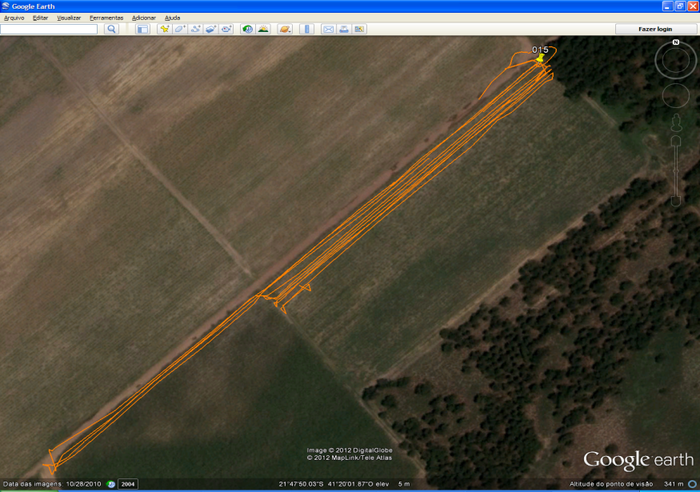
Figure 1.
Image of the area where the sugar cane harvest was carried out, taken from Google Earth
The characteristics of the assessed sugar cane field and soil area are in Tables 1 and 2, respectively, by Manhães et al. (2014).
| Characteristics of the culture | |
| Estimated productivity of the farming (t.ha-1) | 54 |
| Average length of the thatches (m) | 1.5 |
| Average diameter of the thatches (mm) | 20.3 |
| Degree of ripeness of the farming (%) | Brix: 19.5; purity: 78.7; fiber: 19.1 |
| Characteristics of the soil | |
| Moisture content of the soil (0-10 cm) | 41% |
| Moisture content of the soil (10-20 cm) | 44% |
| Soil texture class | Clay |
2.2 Characteristics of the evaluated harvester
The harvester used in this paper to data acquisition on fuel consumption was a CASE IH, model A4000, engine brand Cummins, 6B series, engine potency of 174hp (Figure 2). Its fuel tank is of 210 L. The average harvest speed was 4 km.h -1.
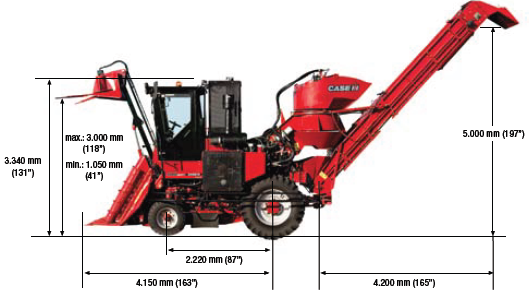
Figure 2.
Side view of the CASE A4000 harvester
2.3 System of automatic data acquisition
The system of automatic data acquisition was built from a volumetric flow sensor to determine the fuel flow, in addition to a data collector (Datalogger) and a global positioning system (GPS).
2.4 Volumetric flow sensor
To determine the fuel flow, a volumetric flow sensor was used, model FLOWMATE Oval M-III LSF45L0-M2, with magnetic sensor, reading pulse unit of 10mL pulse-1, maximum flow of 500 L h-1, voltage from 12 to 24 V of continuum current (VCC), maximum consumption at 10mA and exit pulse type 0/1 = maximum 0.5 VCC / 6.2 at 7.6 VCC, with minimum resistance of 10 kΩ (Figure 3).
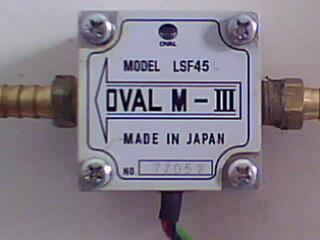
Figure 3.
Volumetric sensor to determine the fuel flow
2.5 Calibration of the volumetric flow sensor
The sensor was connected to a terminal plate, model Protoboard 840, and using jumper wares, and USB AB cable, a connection between the sensor, Arduino plate and computer was carried out (Figure 4).

Figure 4.
Connection of the sensor and Arduino plate
The data acquisition system, after being implemented, was tested with the aim to verify data precision from the sensor and calibrate it.
The sensor was evaluated using volume measurement previously determined from water, of 250, 500, 1,000 and 2,000 mL, at 20 °C. A graduated measuring beaker was used to determine the volume, with a 250 mL capacity, ± 2 mL.
The data coming from the sensor were collected through serial port USB from the computer and presented on the screen of the Arduino program.
The flow sensor was connected to data acquisition system implemented and evaluated in laboratory. The values determined by the beaker and the values determined by the flow sensor (Figure 5) presented adjustment estimated by the linear equation y=0.0043+0.9927x, with determination coefficient r2 = 0.9999, being the model statistically significant at a 1% level of probability. The dispersion diagram presents a positive correlation from variables.
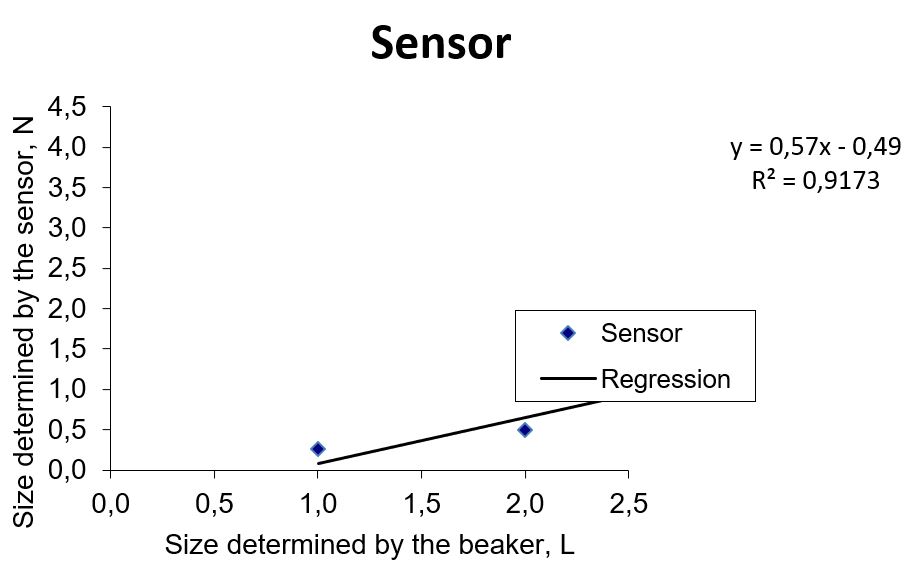
Figure 5.
Data comparison obtained on flow sensor calibration
2.6 Installation of the sensor for volumetric flow in the harvester
The fuel flow meter was installed between the first and second fuel filter, before the injection pump. The return from injector nozzles has its flow altered when installing a connector type “t” before the meter. Sensor for volumetric flow was installed according to Vale et al. (2008), who evaluated the development from the tractor and brushcutter in hoeing operation. The figure 6 shows the sensor for volumetric flow mounted in harvester A4000.
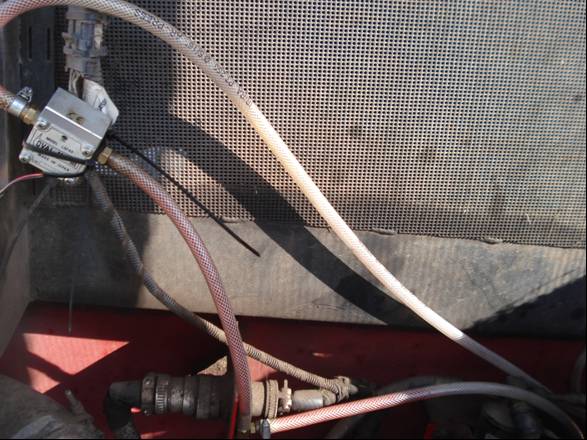
Figure 6.
Sensor for volumetric flow mounted in harvester A4000
2.7 Data collection system
To collect data from the harvester fuel consumption, a Datalogger from Campbell Scientific brand, model CR1000 was used to monitor, transport and store the signs generated by the flow and speed meters. The data collector has the capacity to store 4,000,000 data. For its feeding, it is necessary a minimum voltage of 12 volts and the maximum is 24 volts. The figure 7 shows the image of the datalogger Campbell Scientific, model CR1000.
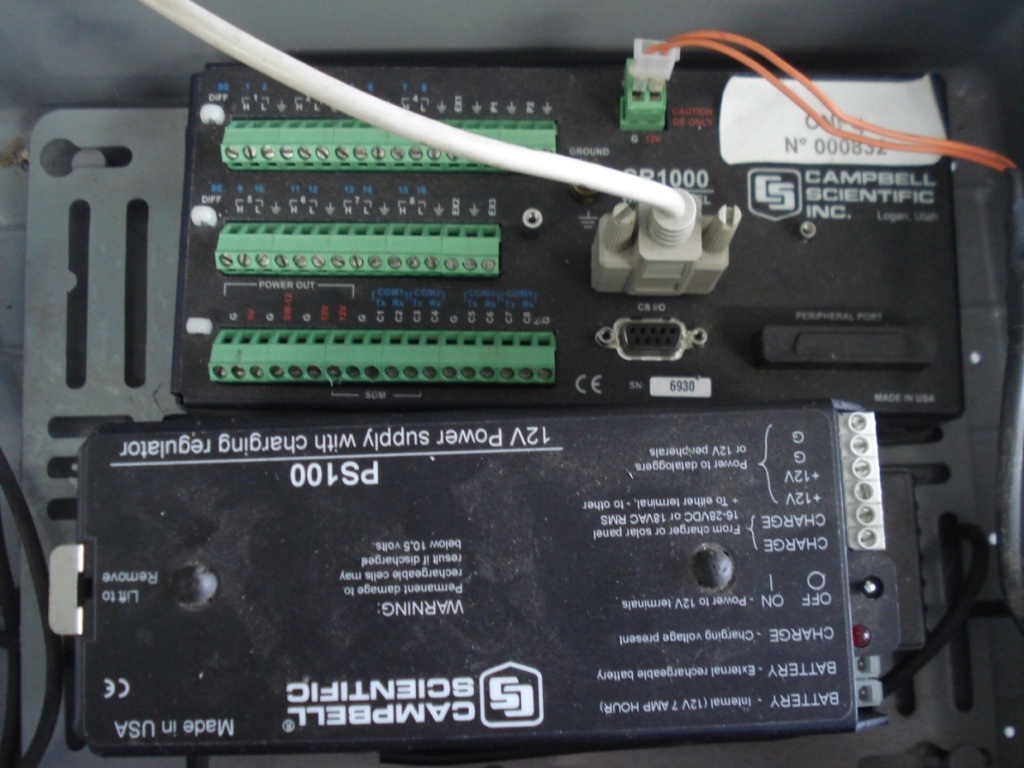
Figure 7.
Datalogger Campbell Scientific, model CR1000
Table 3 demonstrates inputs and outputs from connections of the sensor for volumetric flow and the Datalogger.
| FLOWMATE Oval M-III model LSF45L | Datalogger doors | Function |
| Green: SIG | P2 | Output signal |
| Red: SUP (+VDC) | 12v | Feeding |
| Black: COM (0v) | Ground Wire |
To discharge data obtained by fuel flow sensors, collected through purchasing system, the computer program D-LoggerNet was used after carrying out field tests with the sugar cane harvester.
2.8 Global Positioning System (GPS)
A GPS model Garmin 60Csx was used to mark the points, map the area and determine the harvester position.
The computer program GPS TrackMaker was utilized as an interface to transfer to the computer the data acquired through the GPS.
2.9 Fuel consumption determination
To determine the hourly fuel consumption, data obtained by the fuel flow sensor were used. The pulses collected through flow sensor were converted in volume, considering the relation of 10ml pulse-1
The hourly consumption calculation was carried out according to equation 1.
 (eq .1)
(eq .1)Where:
Ch = Hourly consumption, L h-1;
V = Volume consumed, mL;
T = Journey time in the tranch, s; e
3,6 = Conversion factor.
The calculation of fuel consumption per area was carried out according to equation 2.
 (eq .2)
(eq .2)where:
CCa = fuel consumption per area, L ha-1;
Td = Respondent effective time, h.ha-1;
Ch = Hourly fuel consumption, L h-1
The fuel consumption per ton of harvested cane was calculated by means of equation 3.
 (eq .3)
(eq .3)where:
Ct = Fuel consumption per ton of harvested cane, L.ton-1;
CCa = Fuel consumption per area, L ha-1;
P = Sugar cane crop productivity, ton. ha-1.
3 Results and Discussion
Table 4 presents consumption data from harvester A4000.
| Hourly fuel consumption (L h-1) | 33.9 |
| Effective consumption (L ton-1) | 1.84 |
| Fuel consumption in 20h of work (L) | 678 |
| Productivity estimate (t ha-1) | 54 |
The result generated by the automatic data acquisition system demonstrated that the hourly fuel consumption was 33.9 L h-1 (Table 4). According to Istoé Dinheiro Rural (REFORÇO..., 2009), that reports information under the harvester at the moment of product disclosure, the ideal hourly consumption from harvester A4000 is 16.8 L h-1. The consumption found in this research was greater than the double from the number stipulated by the machine manufacturers when the product was launched.
Lyra (2012) reports the need of evaluating fuel consumption from harvesters in a more intense way, since it is beyond the estimate values for this operation. This author mentions that this high consumption is due to lack of adequate training of the operators, that work with the machine at full blast most of the time, even when it is not necessary. Santos (2012) reports that the hourly fuel consumption from sugar cane harvesters also varies according to engine rotation and traveling speed. The higher the speed is, the lower is the hourly fuel consumption.
In compliance with Lyra (2012), a harvester spends on average 60 L diesel oil to reap one hectare sugar cane. Considering the current diesel oil price as R$2.75 per liter (ANP, 2017), this harvester will spend approximately R$165.00 per hectare reaped. Harvesting about 10 ha a day, the daily expense with fuel is superior than R$ 1,600.00.
According to some information from Coagro, when this evaluation was carried out, the harvester worked for 20 hours. Considering that the fuel consumption has kept the same throughout the work day, the total consumption during the 20 hours work was of 678 liters fuel, meaning that more than three fuel tanks spent in only one day of work and the harvester fuel tank supports 210 liters. These 678 liters mean an expense of R$1,593.30 in one day of harvest.
The effective consumption, which refers to fuel volume used per ton of harvested sugar cane was estimated in 1.84 L t-1 (Table 4). According to Istoé Dinheiro Rural (REFORÇO…, 2009), the effective consumption from harvester A4000 is 0.84 L t-1. The value obtained in this research was higher than the ideal value estimated by the company that manufactured this machine.
The sugar cane productivity estimate was 54 tons per hectare.
Seki (2007) evaluated the operational and energetic performance in the corn harvest of humid (33% water tenor) and dry grains (15.4% water tenor). In the humid grain harvest, the harvester presented speed of 3.27 km h-1, effective operational capacity of 1,12 ha h-1, fuel consumption per hour of 15.31 L h-1 and consumption per area of 13.59 L ha-1. In dry grain harvest, the harvester presented speed of 3.63 km h-1, effective operational capacity of 1.25 ha h-1, fuel consumption per hour of 12.64 L h-1 and consumption per area of 10.14 L ha-1, which means, the effective field capacity of harvest was 10% higher.
4 Conclusions
The hourly fuel consumption and the effective consumption from harvester CASE IH A4000 were greater than the double from the number stipulated by the machine manufacturers, meaning that the consumption is beyond the recommended levels and that the machine might have been deregulated at the time of harvest, causing great damage to the cooperative that was operating it.
Acknowledgments
To CNPq, for the concession of a doctorate scholarship to the first author.
To FAPERJ, for the financial support and for the execution of the research study.
To COAGRO plant by indulging the area of sugarcane and harvest for study.
References
ANP. Agência Nacional de Petróleo. Pesquisa de preços. 2017. Available in: http://www.anp.gov.br/preco/. Accessed in: 3 Sept. 2017.
CERRI, D. G. P. Agricultura de precisão em cana-de-açúcar: instrumentação de uma colhedora, mapeamento da produtividade e de atributos do solo. 2005. 173f. Tese (Doutorado) – Universidade Estadual de Campinas, Faculdade de Engenharia Agrícola, Campinas, 2005.
CONAB. Companhia Nacional de Abastecimento. Monitoramento agrícola: cana-se-açúcar. Acomp. Safra bras. cana, Brasília, v.4, Safra 2017/18, n. 4 – Quarto levantamento, p. 1-73, 2014.
EMBRAPA. Empresa Brasileira de Pesquisa Agropecuária. Sistema brasileiro de classificação de solos. 3. ed. Brasília, 2013. 353p.
LOPES, A. Desempenho de um trator agrícola de acordo com o tipo de pneu, lastro e velocidade de avanço em um solo argiloso. 2000. 131 f. Tese (Doutorado) – Faculdade de Ciências Agrárias, Universidade de São Paulo, Botucatu, 2000.
LYRA, G. A. Consumo de combustível de duas colhedoras de cana-de-açúcar em função da velocidade e rotação de motor. 2012. 53p. Dissertação (Mestrado) – Faculdade de Ciências Agrárias, UNESP, Botucatu, 2012.
MANHÃES, C. M. C. et al. Visible losses in mechanized harvesting of sugarcane using the case IH A4000 harvester. American Journal of Plant Sciences, v. 5, n. 18, 2014.
REFORÇO no campo: novas gerações de máquinas prometem otimizar ainda mais a produtividade das lavouras. Istoé Dinheiro Rural, n. 60, 2009. Available in:https://www.dinheirorural.com.br/secao/agronegocios/reforco-no-campo. Accessed in: 30 Jul. 2017.
RIPOLI, T. C. C. Aumento do interesse na mecanização do plantio. JornalCana, Ribeirão Preto, n. 151, p. 30-31, 2006.
SANTOS, E. C. Colheita mecanizada de cana-de-açúcar (Sacchaurum spp.) sem queima prévia: análise de parâmetros de desempenho efetivo. 2012. 142 p. Dissertação (Mestrado) – Universidade de São Paulo, 2012.
SCHMIDT JUNIOR, J. C. Avaliação de desempenho efetivo de colhedora de cana-de-açúcar (Sacchaurum spp.). 2011. 110p. Dissertação (Mestrado) – Universidade de São Paulo, 2011.
SEKI, A. S. Demanda energetica no processo de ensilagem de milho. 2007. 101 f. Dissertação (Mestrado) – Faculdade de Ciências Agronômicas, UNESP, Botucatu, 2007.
VALE, W. G. et al. Desempenho e dimensionamento amostral para avaliação de uma semeadora- semeadora-adubadora em plantio adubadora em plantio adubadora em plantio direto e direto e direto e convencional convencional convencional. Acta Scientiarum. Agronomy, v. 30, n. 4, p. 441-44
Notas de autor